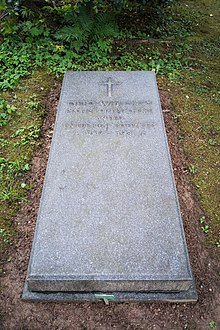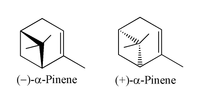Otto Wallach
Otto Wallach | |
|---|---|
 Wallach c. 1873 | |
| Born | (1847-03-27)27 March 1847 Königsberg, Prussia |
| Died | 26 February 1931(1931-02-26) (aged 83) Göttingen, Germany |
| Nationality (legal) | Prussia / German Empire |
| Alma mater | University of Göttingen |
| Known for | Isoprene rule |
| Awards | Nobel Prize for Chemistry (1910) Davy Medal (1912) |
| Scientific career | |
| Fields | Organic chemistry |
| Institutions | University of Göttingen, University of Bonn |
| Doctoral advisor | Hans Hübner[citation needed] |
| Doctoral students | Walter Haworth, Adolf Sieverts |

Otto Wallach (German pronunciation: [ˈɔto ˈvalax] ⓘ; 27 March 1847 – 26 February 1931) was a German chemist and recipient of the 1910 Nobel Prize in Chemistry for his work on alicyclic compounds.[1][2]
Biography
Wallach was born in Königsberg, the son of a Prussian civil servant. His father, Gerhard Wallach, descended from a Jewish family that had converted to Lutheranism. His mother, Otillie (Thoma),[3] was an ethnic German of Protestant religion. Wallach's father was transferred to Stettin (Szczecin) and later to Potsdam. Otto Wallach went to school, a Gymnasium, in Potsdam, where he learned about literature and the history of art, two subjects he was interested his whole life. At this time he also started private chemical experiments at the house of his parents.
In 1867 he started studying chemistry at the University of Göttingen, where at this time Friedrich Wöhler was head of organic chemistry. After one semester at the University of Berlin with August Wilhelm von Hofmann, Wallach received his Doctoral degree from the University of Göttingen in 1869,[4] and worked as a professor in the University of Bonn (1870–89) and the University of Göttingen (1889–1915). Two of his doctoral students were Adolf Sieverts and Walter Haworth.[5] Wallach died at Göttingen. In 1912, he was awarded the Davy Medal.
He died on 26 February 1931, and was buried in the Göttingen.
Major works
During his work with Friedrich Kekulé in Bonn he started a systematic analysis of the terpenes present in essential oils. Up to this time only a few had been isolated in pure form, and structural information was sparse. Melting point comparison and the measurement of mixtures was one of the methods to confirm identical substances. For this method the mostly liquid terpenes had to be transformed into crystalline compounds. With stepwise derivatisation, especially additions to the double bond present in some of the terpenes, he achieved the goal of obtaining crystalline compounds. The investigation of the rearrangement reactions of cyclic unsaturated terpenes made it possible to obtain the structure of an unknown terpene by following the rearrangement to a known structure of a terpene. With these principal methods he opened the path to systematic research on terpenes.

He was responsible for naming terpene and pinene, and for undertaking the first systematic study of pinene.
He wrote a book about the chemistry of terpenes, "Terpene und Campher" (1909).[citation needed]
Otto Wallach is known for Wallach's rule, Wallach degradation, the Leuckart-Wallach reaction (which he developed along with Rudolf Leuckart) and the Wallach rearrangement.[citation needed]
Works
- Tabellen zur chemischen Analyse. Weber, Bonn 1880. Digital edition of the University and State Library Düsseldorf.
- 1. Verhalten der Elemente und ihrer Verbindungen. 1880
- 2. Methoden zur Auffindung und Trennung der Elemente. 2. Aufl. von "Hülfstabellen für den chemisch-analytischen Unterricht" 1880
- Terpene und Campher : Zusammenfassung eigener Untersuchungen auf dem Gebiet der alicyclischen Kohlenstoffverbindungen. 2. Aufl. Leipzig : von Veit, 1914. Digital edition of the University and State Library Düsseldorf.
See also
References
- ^ Leopold Ruzicka (1932). "Third Pedler lecture. The life and work of Otto Wallach". J. Chem. Soc.: 1582. doi:10.1039/JR9320001582.
- ^ Christmann, M (2010). "Otto Wallach: Founder of Terpene Chemistry and Nobel Laureate 1910". Angewandte Chemie International Edition. 49 (50): 9580–9586. doi:10.1002/anie.201003155. PMID 21110354.
- ^ Frank Northen Magill (1990). 1901–1937. Salem Press. ISBN 978-0-89356-562-6.
- ^ Otto Wallach (1869). Über vom Toluol abgeleitete neue isomere Verbindungen: Inaug. Diss. E. A. Huth.
- ^ "Chemistry Tree - Otto Wallach". academictree.org. Retrieved 23 March 2019.
External links

- Otto Wallach on Nobelprize.org
 including the Nobel Lecture, 12 December 1910 Alicyclic Compounds
including the Nobel Lecture, 12 December 1910 Alicyclic Compounds
- v
- t
- e
- 1901: Jacobus van 't Hoff
- 1902: Emil Fischer
- 1903: Svante Arrhenius
- 1904: William Ramsay
- 1905: Adolf von Baeyer
- 1906: Henri Moissan
- 1907: Eduard Buchner
- 1908: Ernest Rutherford
- 1909: Wilhelm Ostwald
- 1910: Otto Wallach
- 1911: Marie Curie
- 1912: Victor Grignard / Paul Sabatier
- 1913: Alfred Werner
- 1914: Theodore Richards
- 1915: Richard Willstätter
- 1916
- 1917
- 1918: Fritz Haber
- 1919
- 1920: Walther Nernst
- 1921: Frederick Soddy
- 1922: Francis Aston
- 1923: Fritz Pregl
- 1924
- 1925: Richard Zsigmondy

- 1926: Theodor Svedberg
- 1927: Heinrich Wieland
- 1928: Adolf Windaus
- 1929: Arthur Harden / Hans von Euler-Chelpin
- 1930: Hans Fischer
- 1931: Carl Bosch / Friedrich Bergius
- 1932: Irving Langmuir
- 1933
- 1934: Harold Urey
- 1935: Frédéric Joliot-Curie / Irène Joliot-Curie
- 1936: Peter Debye
- 1937: Norman Haworth / Paul Karrer
- 1938: Richard Kuhn
- 1939: Adolf Butenandt / Leopold Ružička
- 1940
- 1941
- 1942
- 1943: George de Hevesy
- 1944: Otto Hahn
- 1945: Artturi Virtanen
- 1946: James B. Sumner / John Northrop / Wendell Meredith Stanley
- 1947: Robert Robinson
- 1948: Arne Tiselius
- 1949: William Giauque
- 1950: Otto Diels / Kurt Alder
- 1951: Edwin McMillan / Glenn T. Seaborg
- 1952: Archer Martin / Richard Synge
- 1953: Hermann Staudinger
- 1954: Linus Pauling
- 1955: Vincent du Vigneaud
- 1956: Cyril Hinshelwood / Nikolay Semyonov
- 1957: Alexander Todd
- 1958: Frederick Sanger
- 1959: Jaroslav Heyrovský
- 1960: Willard Libby
- 1961: Melvin Calvin
- 1962: Max Perutz / John Kendrew
- 1963: Karl Ziegler / Giulio Natta
- 1964: Dorothy Hodgkin
- 1965: Robert Woodward
- 1966: Robert S. Mulliken
- 1967: Manfred Eigen / Ronald Norrish / George Porter
- 1968: Lars Onsager
- 1969: Derek Barton / Odd Hassel
- 1970: Luis Federico Leloir
- 1971: Gerhard Herzberg
- 1972: Christian B. Anfinsen / Stanford Moore / William Stein
- 1973: Ernst Otto Fischer / Geoffrey Wilkinson
- 1974: Paul Flory
- 1975: John Cornforth / Vladimir Prelog
- 1976: William Lipscomb
- 1977: Ilya Prigogine
- 1978: Peter D. Mitchell
- 1979: Herbert C. Brown / Georg Wittig
- 1980: Paul Berg / Walter Gilbert / Frederick Sanger
- 1981: Kenichi Fukui / Roald Hoffmann
- 1982: Aaron Klug
- 1983: Henry Taube
- 1984: Robert Merrifield
- 1985: Herbert A. Hauptman / Jerome Karle
- 1986: Dudley R. Herschbach / Yuan T. Lee / John Polanyi
- 1987: Donald J. Cram / Jean-Marie Lehn / Charles J. Pedersen
- 1988: Johann Deisenhofer / Robert Huber / Hartmut Michel
- 1989: Sidney Altman / Thomas Cech
- 1990: Elias Corey
- 1991: Richard R. Ernst
- 1992: Rudolph A. Marcus
- 1993: Kary Mullis / Michael Smith
- 1994: George Olah
- 1995: Paul J. Crutzen / Mario Molina / F. Sherwood Rowland
- 1996: Robert Curl / Harold Kroto / Richard Smalley
- 1997: Paul D. Boyer / John E. Walker / Jens Christian Skou
- 1998: Walter Kohn / John Pople
- 1999: Ahmed Zewail
- 2000: Alan J. Heeger / Alan MacDiarmid / Hideki Shirakawa
- 2001: William Knowles / Ryoji Noyori / K. Barry Sharpless
- 2002: John B. Fenn / Koichi Tanaka / Kurt Wüthrich
- 2003: Peter Agre / Roderick MacKinnon
- 2004: Aaron Ciechanover / Avram Hershko / Irwin Rose
- 2005: Robert H. Grubbs / Richard R. Schrock / Yves Chauvin
- 2006: Roger D. Kornberg
- 2007: Gerhard Ertl
- 2008: Osamu Shimomura / Martin Chalfie / Roger Y. Tsien
- 2009: Venkatraman Ramakrishnan / Thomas A. Steitz / Ada E. Yonath
- 2010: Richard F. Heck / Akira Suzuki / Ei-ichi Negishi
- 2011: Dan Shechtman
- 2012: Robert Lefkowitz / Brian Kobilka
- 2013: Martin Karplus / Michael Levitt / Arieh Warshel
- 2014: Eric Betzig / Stefan Hell / William E. Moerner
- 2015: Tomas Lindahl / Paul L. Modrich / Aziz Sancar
- 2016: Jean-Pierre Sauvage / Fraser Stoddart / Ben Feringa
- 2017: Jacques Dubochet / Joachim Frank / Richard Henderson
- 2018: Frances Arnold / Gregory Winter / George Smith
- 2019: John B. Goodenough / M. Stanley Whittingham / Akira Yoshino
- 2020: Emmanuelle Charpentier / Jennifer Doudna
- 2021: David MacMillan / Benjamin List
- 2022: Carolyn R. Bertozzi / Morten P. Meldal / Karl Barry Sharpless
- 2023: Moungi G. Bawendi / Louis E. Brus / Alexei I. Ekimov









